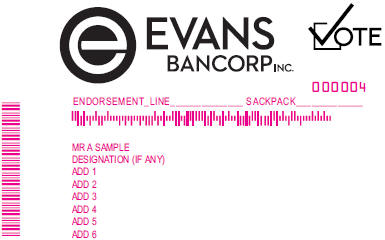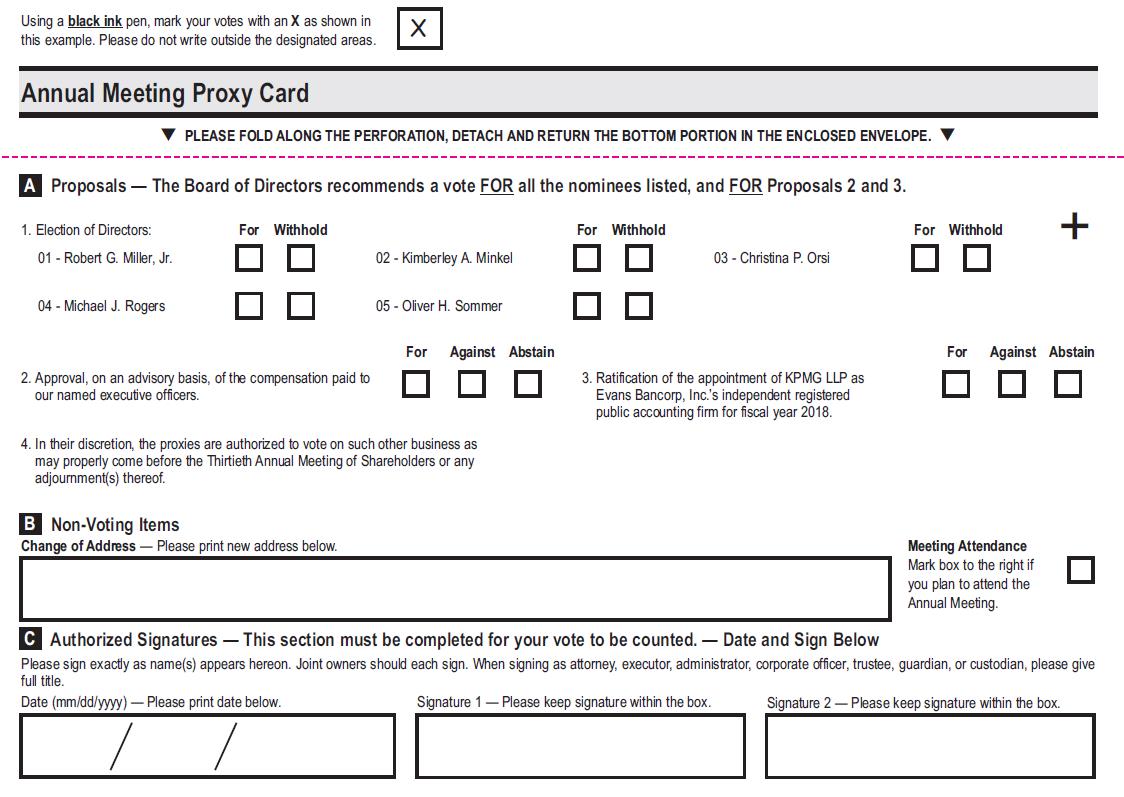Board of Director Committees
may be disregarded by the presiding officer of the meeting, in his or her discretion, and upon his or her instruction, the inspectors of election may disregard all votes cast for each such nominee. However, in the event that any such nominee is nominated by more than one shareholder, the nomination shall be honored, and all votes cast in favor of such nominee shall be counted if at least one nomination for that person complies with the provisions of the bylaws of the Company.
The process whereby the Corporate Governance and Nominating Committee identifies director candidates may include identification of individuals well-known in the community in which the Company operates and individuals recommended to the Corporate Governance and Nominating Committee by current directors or officers who know those individuals through business or other professional relationships, as well as recommendations of individuals to the Corporate Governance and Nominating Committee by shareholders and customers. The Company has not historically received director candidate recommendations from its shareholders. However, the Corporate Governance and Nominating Committee will consider qualified nominees recommended by shareholders, and there is no difference in the manner in which the Corporate Governance and Nominating Committee will evaluate director candidates recommended by shareholders, as opposed to director candidates presented for consideration to the Corporate Governance and Nominating Committee by directors, officers or otherwise. The Corporate Governance and Nominating Committee, in conjunction with the CEO, maintains a list of potential director candidates based upon community reputation and contacts, record of accomplishments, and skill set. Additionally, the Corporate Governance and Nominating Committee reviews committee and Board assessments for competencies and needs and seeks to identify candidates that will assist in the continued development and enhancement of the Board of Directors. In its evaluation of prospective director candidates, the Corporate Governance and Nominating Committee considers an individual’s independence (as defined in the listing rules of the NYSE American), as well as his or her skills and experience relative to the needs of the Company. Director candidates meet personally with the members of the Corporate Governance and Nominating Committee and are interviewed to determine their satisfaction of the criteria referred to above. Although the Company has no policy regarding diversity, the charter of the Corporate Governance and Nominating Committee provides that diversity is one of the criteria it may consider when selecting individuals to recommend for Board membership, together with independence, sound judgment, skill, integrity, willingness to make the required time commitment, understanding of financial statements and knowledge of and experience in the Company’s and its subsidiaries’ businesses, and the interplay of a candidate’s experience with the experience of other members of the Board of Directors.
Enterprise Risk Committee:
| | |
| |
| Nora B. Sullivan, Chair | | Kimberley A. Minkel |
| |
Michael A. Battle | | David J. Nasca |
| |
| James E. Biddle, Jr. | | Michael J. Rogers |
| |
| Kevin D. Maroney | | Lee C. Wortham |
| |
Robert G. Miller, Jr. | | |
Our Enterprise Risk Committee (“ERC”), which is responsible for overseeing and approving company-wide risk management practices throughout the Company, overseeing management’s risk assessment process and risk management infrastructure, reviewing management’s risk-management framework in the context of the Company’s size and business activities, and advising on risks that the Company may face. The ERC will review and discuss with management, at least annually, the Company’s risk governance structure and the Company’s risk management and risk assessment guidelines and policies regarding market, credit, operations, liquidity, funding, reputation, cybersecurity and franchise risk, and the Company’s risk tolerance. The ERC will review at least quarterly the major risk exposures of the Company and its business units against established risk management methodologies and targets. The Board’s role in the Company’s risk oversight process includes receiving reports, at least quarterly, from members of senior management on areas of material risk to the Company, including operational, financial, credit, liquidity, legal and regulatory, and strategic and reputational risks. The full Board (or the appropriate committee in the case of risks that are under the purview of a particular committee) receives these reports from the appropriate “risk owner” within the organization to enable it to understand our risk identification, risk management and risk mitigation strategies. When a committee receives the report, the chairman of the relevant committee reports on the discussion to the full Board during the committee reports portion of the next Board meeting. This enables the Board and its committees to coordinate the risk oversight role, particularly with respect to risk interrelationships. The Board’s role in the Company’s risk oversight process has not directly impacted its leadership structure.
Compensation Risk. The Human Resource and Compensation Committee considers risk and its influence on the Company's compensation programs. This Committee reviews each compensation element individually and in the aggregate to ensure that the overall compensation program provides a balanced perspective that ultimately aligns pay with performance while also ensuring bonus / incentive programs do not motivate inappropriate risk-taking. Equity award levels and practices are set to foster shared interests between management and shareholders, but are not considered by the Committee to be at levels that would drive inappropriate behavior. In the Committee's judgment, the compensation policies and practices of the Company do not give rise to material risks.
In addition, the Company is subject to guidance issued by the FDIC, the FRB and the OCC designed to ensure that incentive compensation arrangements at banking organizations appropriately tie rewards to longer-term performance and do not undermine the safety and soundness of the firm or create undue risks to the financial system. This guidance embodies three core principles, which are: (1) incentive compensation arrangements at a banking organization should provide employees incentives that appropriately balance risk and financial results in a manner that does not encourage employees to expose their organizations to imprudent risks; (2) these arrangements should be compatible with effective controls and risk management, and (3) these arrangements should be supported by strong corporate governance, including active and effective oversight by the organization’s board of directors. We believe that our incentive compensation programs are in compliance with this guidance.
Policy for Director Attendance at Annual Meeting. It is the policy of the Company that all directors be present at the Annual Meeting, barring unforeseen or extenuating circumstances. All directors who were then serving were present at the Company’s 2017 Annual Meeting.
Shareholder Communications with the Board of Directors. Shareholders and other parties interested in communicating directly with the Company’s Board of Directors may do so by writing to the Evans Bancorp, Inc. Board of Directors, One Grimsby Drive, Hamburg, NY 14075. All correspondence received under this process is compiled and summarized by the Executive Assistant to the President and Chief Executive Officer of the Company and presented to the Board of Directors, in accordance with our Policy for Communication to the Board of Directors. Concerns relating to accounting, internal controls or auditing matters are handled in accordance with procedures established by the Audit Committee, as set forth in our Employee Complaint Procedure for Accounting and Auditing Matters. Each of these policies is available in the Governance Documents section of the Company’s website (www.evansbancorp.com), which can be found under the “Corporate Overview” tab.
Code of Ethics for Chief Executive Officer and Principal Financial Officers. The Company has a "Chief Executive Officer/Treasurer/Controller Code of Ethics," which is applicable to the Company’s principal executive officer, principal financial officer, and principal accounting officer. The "Chief Executive Officer/Treasurer/ControllerCode of Ethics" is available in the Governance Documents section of the Company’s website (www.evansbancorp.com), which can be found under the “Corporate Overview” tab. The Company intends to post amendments to or waivers from its code of ethics at this location on its website.
Board Meetings and Attendance at Board of Director and Committee Meetings. The Company’s Board of Directors met eleven times during fiscal 2017, including one strategic planning meeting. Each incumbent director attended at least 75% of the aggregate of: (1) all meetings of the Company’s Board of Directors (held during the period for which he or she served as a director) and (2) all meetings held by the committees of the Company’s Board of Directors on which he or she served (during the periods that he or she served).
Availability of Committee Charters and Other Corporate Governance Documents. Current copies of the written charters for the Audit Committee, the Human Resource and Compensation Committee, and the Corporate Governance and Nominating Committee, copies of the Company's "Chief Executive Officer/Treasurer/Controller Code of Ethics" and the "Code of Conduct," the "Policy for Communication to the Board of Directors," and the “Employee Complaint Procedure for Accounting and Auditing Matters” are available in the Governance Documents section of the Company's website (www.evansbancorp.com), which can be found under the “Corporate Overview” tab.
BOARD OF DIRECTOR COMMITTEES
The Company’s Board of Directors has four outstanding committees: the Audit Committee, the Corporate Governance and Nominating Committee, the Human Resource and Compensation Committee and the Enterprise Risk Committee. The members of each committee have been nominated by the Chairman of the Board of Directors and approved by the full Board. The names of the members of the Audit Committee, the Human Resource and Compensation Committee, and the Corporate Governance and Nominating Committee, together with a brief description of their functions, are set forth below.
Audit Committee:
| | |
2021 Proxy Statement | | |
Michael J. Rogers, Chairman
| Nora B. Sullivan
|
John R. O'Brien
| Lee C. Wortham
|
The Audit Committee met six times during fiscal 2017. The Audit Committee is responsible for reviewing the financial information of the Company that will be provided to shareholders and others, overseeing the systems of internal controls which management and the Board of Directors have established, selecting and monitoring the performance of the Company’s independent auditors, and overseeing the Company’s audit and financial reporting processes. The Board of Directors has determined that John R. O’Brien, Michael J.
Rogers, Nora B. Sullivan and Lee C. Wortham each qualify as an “audit committee financial expert” as defined in Item 407(d) of Regulation S-K, and that each member of the Audit Committee is an "independent director" in accordance with applicable NYSE American listing requirements, including the heightened independence requirements applicable to Audit Committee members, and Rule 10A-3(b)(1) under the Exchange Act. The Board of Directors has adopted an Audit Committee Charter, which is available in the Governance Documents section of the Company's website at www.evansbancorp.com, which can be found under the “Corporate Overview” tab.
Human Resource and Compensation Committee:
| |
Thomas H. Waring, Jr., Chairman
| John R. O’Brien
|
James E. Biddle, Jr.
| Lee C. Wortham
|
David R. Pfalzgraf, Jr.
| |
The Human Resource and Compensation Committee met six times during fiscal 2017. The Human Resource and Compensation Committee is responsible for administering the Company’s 2009 Long-Term Equity Incentive Plan and awarding new grants thereunder, for administering the Evans Excels Performance Incentive Plan, the Employee Stock Purchase Plan, the Executive Severance Plan, the SERP Plans (defined below), the Deferred Compensation Plan, and the Executive Incentive Retirement Plan for making such determinations and recommendations as the Human Resource and Compensation Committee deems necessary or appropriate regarding the remuneration and benefits of employees of the Company and its subsidiaries and, in addition, for reviewing with management the Compensation Discussion and Analysis and providing a report recommending to the Board of Directors whether the Compensation Discussion and Analysis should be included in the Proxy Statement.
The Human Resource and Compensation Committee has the authority to act on behalf of the Board of Directors in setting compensation policy, administering Board or shareholder approved compensation plans, approving benefit programs and making decisions for the Board with respect to compensation of senior management. Except as otherwise required by the applicable rules of the SEC or the NYSE American, the Human Resource and Compensation Committee may delegate any of its responsibilities to a subcommittee comprised of one or more members of the Human Resource and Compensation Committee, the Board or members of management. As discussed in more detail below under “Compensation Discussion and Analysis,” the Company’s executive officers may attend Human Resource and Compensation Committee meetings to present data and analysis and to make recommendations regarding compensation, benefit plans and promotions for executive officers other than the President and CEO. The Human Resource and Compensation Committee, on an annual basis, reviews and approves corporate goals and objectives relevant to CEO and other officer compensation, evaluates the performance of the CEO and the other executive officers in light of those goals and objectives, and determines and recommends compensation levels for the CEO and the other executive officers to the full Board of Directors based on this evaluation.
The Human Resource and Compensation Committee also has the authority to review and recommend to the full Board for approval director compensation, including board fees, committee fees and additional compensation, including awards of restricted stock and stock options.
In carrying out its duties, the Human Resource and Compensation Committee has the authority to retain, at the Company’s expense, to oversee the work of, and to terminate, a compensation consultant. The Human Resource and Compensation Committee also has the authority to retain independent counsel and other advisors at the Company’s expense. The Committee did not engage an independent compensation consultant or other advisor during 2017. During 2016, the Human Resource and Compensation Committee engaged Pearl Meyer & Partners, an executive compensation consultant specializing in community bank compensation plans, to provide advisory services regarding executive and director compensation.
The Committee reviews and re-approves, on an annual basis, its committee charter and the Company’s compensation philosophy, which is described in greater detail below. The Committee also conducts an annual self-assessment to confirm the Committee’s satisfactory completion of its responsibilities under its committee charter. As a result of its 2017 self-assessment, the Committee concluded that it was meeting its objectives as set forth in its committee charter.
The Board of Directors has determined that each of the members of the Human Resource and Compensation Committee is an “independent director,” in accordance with applicable NYSE American listing requirements, including the heightened independence requirements applicable to compensation committee members. The Board of Directors has adopted a Human Resource and Compensation Committee Charter, which is available in the Governance Documents section of the Company’s website at www.evansbancorp.com, which can be found under the “Corporate Overview” tab
Corporate Governance and Nominating Committee:
| |
David R. Pfalzgraf, Jr., Chairman
| Thomas H. Waring, Jr.
|
Nora B. Sullivan
| Jody L. Lomeo
|
John R. O’Brien
| Michael A. Battle
|
The Corporate Governance and Nominating Committee met five times during fiscal 2017. Its purpose is to assist the Board in developing and implementing corporate governance guidelines for the Company, and to provide oversight of the corporate governance affairs of the Company, including strategic planning. It is also charged with the responsibility of identifying and recommending to the Board candidates for director nominees to be presented to the shareholders for their consideration at the Annual Meetings of Shareholders, and to fill vacancies on the Board of Directors. The director nominees for the Annual Meeting were selected by a majority of the independent directors of the full Board. The Board of Directors has determined that each of the members of the Corporate Governance and Nominating Committee is an "independent director," in accordance with applicable NYSE American listing requirements. The Board of Directors has adopted a Corporate Governance and Nominating Committee Charter, which is available in the Governance Documents section of the Company’s website at www.evansbancorp.com, which can be found under the “Corporate Overview” tab.
The Company's bylaws set out the procedure to be followed by shareholders desiring to nominate directors for consideration at an annual meeting of shareholders. Under the Company's bylaws, shareholder director nominations must be submitted to the Secretary of the Company in writing not less than 14 days nor more than 50 days immediately preceding the date of the annual meeting. If less than 21 days notice of the annual meeting is given to shareholders, nominations must be mailed or delivered to the Secretary of the Company not later than the close of business on the seventh day following the day on which the notice of meeting was mailed. Such notification must contain the following information to the extent known by the notifying shareholder: (a) name and address of each proposed nominee; (b) the principal occupation of each proposed nominee; (c) the total number of shares of common stock of the Company that will be voted for each proposed nominee; (d) the name and residence address of the notifying shareholder; and (e) the number of shares of common stock of the Company owned by the notifying shareholder. Candidates for nomination to the Board of Directors must meet criteria established from time to time by the Board of Directors or a duly authorized committee of the Board. Additionally, the Company's bylaws require that, in order to serve as a director of the Company, an individual must be less than 70 years of age. The Company’s bylaws provide that a Director who obtains the age of seventy (70) years old during his or her term as a Director may remain in office through the expiration of his or her term.Compensation Nominations not made in accordance with the bylaws of the Company may be disregarded by the presiding officer of the meeting, in his or her discretion, and upon his or her instruction, the inspectors of election may disregard all votes cast for each such nominee. However, in the event that any such nominee is nominated by more than one shareholder, the nomination shall be honored, and all votes cast in favor of such nominee shall be counted if at least one nomination for that person complies with the provisions of the bylaws of the Company.
The process whereby the Corporate Governance and Nominating Committee identifies director candidates may include identification of individuals well-known in the community in which the Company operates and individuals recommended to the Corporate Governance and Nominating Committee by current directors or officers who know those individuals through business or other professional relationships, as well as recommendations of individuals to the Corporate Governance and Nominating Committee by shareholders and customers. The Company has not historically received director candidate recommendations from its shareholders. However, the Corporate Governance and Nominating Committee will consider qualified nominees recommended by shareholders, and there is no difference in the manner in which the Corporate Governance and Nominating Committee will evaluate director candidates recommended by shareholders, as opposed to director candidates presented for consideration to the Corporate Governance and Nominating Committee by directors, officers or otherwise. The Corporate Governance and Nominating Committee, in conjunction with the CEO, maintain a list of potential director candidates based upon community reputation and contacts, record of accomplishment, and skill set. Additionally, the Corporate Governance and Nominating Committee reviews committee and Board assessments for competencies and needs and seeks to identify candidates that will assist in the continued development and enhancement of the Board of Directors. In its evaluation of prospective director candidates, the Corporate Governance and Nominating Committee considers an individual's independence (as defined in the listing rules of the NYSE American), as well as his or her skills and experience relative to the needs of the Company. Director candidates meet personally with the members of the Corporate Governance and Nominating Committee and are interviewed to determine their satisfaction of the criteria referred to above. Although the Company has no policy regarding diversity, the charter of the Corporate Governance and Nominating Committee provides that diversity is one of the criteria the Nominating Committee may consider when selecting individuals to recommend for Board membership, together with independence, sound judgment, skill, integrity, willingness to make the required time commitment, understanding of financial statements and knowledge of and experience in the Company’s and its subsidiaries’ businesses, and the interplay of a candidate’s experience with the experience of other members of the Board of Directors. After working with the CEO to meet with and interview Ms. Minkel and Ms. Orsi, the Corporate Governance and Nominating Committee recommended them for nomination to the Board.
DIRECTOR COMPENSATION
Director Compensation Philosophy. The Company’s Director Compensation Programdirector compensation program is designed to provide a compensation amount and structure that will attract and retain highly competent, skilled and engaged individuals for Board service. In order to ensure that its director compensation program remains competitive but appropriate, the Human Resource and Compensation Committee reviews director compensation, on an annual basis, against the same proxy peer group as that used in the review of executive compensation, as described below under “Executive Compensation – Compensation Discussion and Analysis.” The desired total director compensation is at the 50th percentile of the proxy peer group and is delivered in both cash and equity. This splitWhile many of the companies in our proxy peer group do not rely on equity compensation for their directors, the Human Resource and Compensation Committee believes that using a mix of cash and equity compensation aligns director compensation with long term shareholder value, and provideswhile at the same time providing directors with an appropriate compensation for their service.
Director Fees. Each director of the Company also serves as a member of the Board of Directors of the Bank. Non-employee directors do not receive compensation for attending meetings of the Bank’s Board, but do receive committee meeting fees. It is the policy of the Board that employee directors are not paid for their service on the Company'sCompany’s or the Bank'sBank’s Board of Directors in addition to their regular employee compensation.
During fiscal 2017:2020:
Non-employeeNon-employee directors were paid a retainer at the rate of $1,125$1,708 in cash, payable on a monthly basis, and $1,125$1,708 per month in shares of restricted stock payable as a lump sum grant equal to $13,500$20,500 at the FebruaryJanuary board meeting. The number of shares of restricted stock awarded is calculated by dividing $13,500$20,500 by the closing price for a share of the Company’s common stock on the NYSE American on the date of grant. In February 2017,January 2020, each non-employee director except for Mr. Lomeo, Mr. Sommer, and Ms. Henderson received a grant of 340520 shares of restricted stock, at a grant date fair value of $39.70$39.43 per share, for service during 2017.2020. In May of 2020, Mr. Lomeo and Mr. Sommer eachMaroney, upon joining the board following our acquisition of Fairport Savings Bank, received a grant of 260559 shares of restricted stock at a grant date fair value of $39.00 per share, equal to $10,140$24.44 for his service as a non-employeedirector beginning in April 2017 through December 2017. Ms. Henderson received a grantfor the remainder of 113 shares
of restricted stock, at a grant date fair value of $39.70 per share equal to $4,486 for her service as a director during 2017 prior to retirement as of March 31, 2017.2020. Each restricted stock grant vests 100% on the first anniversary of the grant date, subject to full acceleration of vesting upon an individual’s death, disability, retirement or involuntary termination in connection with a change in control of the Company. Vesting of restricted stock grants is accelerated on a pro-rated basis upon the individual’s resignation.
Non-employeeNon-employee directors were paid an annual cash retainer fee per committee as follows, with the fee paid over the course of the year in 12 equal monthly installments. In recognition of their heightened responsibilities, each committee chairperson is entitled to an increased annual retainer as described below. Members of the Enterprise Risk Committee did not receive an annual retainer and instead were paid per meeting attended, as set forth below.
Audit Committee: Chairperson $6,750, Member $3,750 | ·
| | Audit Committee: Chairperson $5,800, Member $3,200
|
| ·
| | Human Resources and Compensation Committee: Chairperson $3,800, Member $2,600
|
| ·
| | Corporate Governance and Nominating Committee: Chairperson $2,400, Member $1,600
|
| ·
| | Enterprise Risk Committee: Chairperson $600 per meeting, Member $400 per meeting
|
Human Resources and Compensation Committee: Chairperson $4,750, Member $3,150
Corporate Governance and Nominating Committee: Chairperson $3,350, Member $2,150
Enterprise Risk Committee: Chairperson $800 per meeting, Member $600 per meeting
Non-employeeNon-employee directors received $400$600 for attendance at a strategic planning meeting held outside of normal monthly Board meetings and regular committee meetings.
In addition to the annual service fee described above and Board meeting fees, the individual serving as Chairman of the Company’s Board of Directors and the Bank’s Board of Directors is entitled to receive an annual fee of $40,000. He or she does not receive committee meeting fees while serving as Chairman.
In addition to the annual service fee described above and Board and committee meeting fees, the individual serving as Vice Chairman of the Company’s Board of Directors and the Bank’s Board of Directors is entitled to receive an annual fee of $5,000.

























































 IF VOTING BY MAIL, SIGN, DETACH AND RETURN THE BOTTOM PORTION IN THE ENCLOSED ENVELOPE.
IF VOTING BY MAIL, SIGN, DETACH AND RETURN THE BOTTOM PORTION IN THE ENCLOSED ENVELOPE. 









